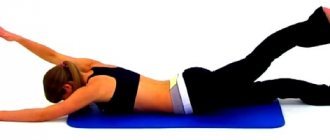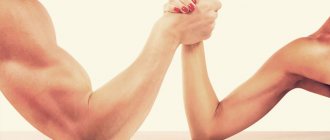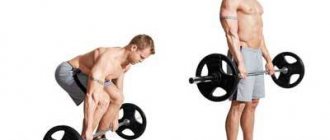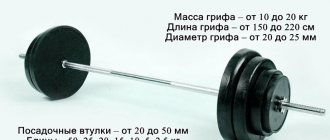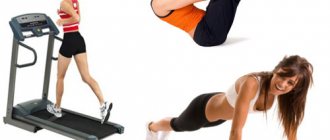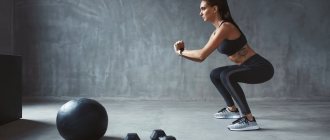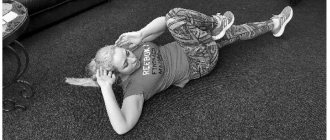The triceps brachii muscle functions as an extensor of the upper limb and responds well to even the slightest load. It is easily hypertrophied and recovers quite quickly. Moreover, you can load the triceps either by straightening the elbow joint directly, performing isolated exercises, or using various classic presses, using the deltoid region of the shoulder in parallel. This muscle group occupies 2/3 of the arm volume and plays a significant role in many basic movements. Many professional athletes pay enough attention to small muscles like the triceps, which helps them progress in their main activity.
Today we will look at the six most effective triceps exercises that both men and women can perform at home.
- Triceps exercises for men
- Triceps exercises for women
- Triceps stretch
Narrow push-ups (diamond)
A classic exercise that equally loads all triceps heads. In the diamond version, the emphasis is shifted to the long head of the muscle.
- Take a position lying on straightened arms.
- Place the brushes at a distance of 10-15 cm from each other.
- As you inhale, lower your body down, bending your elbows.
- As you exhale, push yourself off the floor.
When performing the exercise, bending your elbows, try to keep your hands as close to your body as possible.
Perform 4 sets of 15-20 repetitions.
Standing one-arm dumbbell extension
In this version, a dumbbell triceps extension is performed with only one hand. The work involves the lateral and long head of the triceps, tendon and elbow muscle.
- While standing or sitting, raise your straight arm from the dumbbells above your head, with your hand positioned above your shoulder joint.
- Inhale: Keeping your elbow stationary, lower the dumbbell behind your head without touching your shoulder blade.
- Exhale: straighten your elbow using your triceps. Do not move your shoulder, do not arch your body. If necessary, at the end you can help the triceps with your free hand, pushing out the forearm, or supporting the shoulder in front, for joint stability.
Repeat 8-12 times on one hand, then switch. So 4 approaches.
Read more about how to do a French press sitting and standing here →
Reverse bench/sofa push-ups
At home, the bench can be replaced with a sofa/chairs, which will perfectly replace the bars.
- Place one or two chairs behind you and one in front.
- Sit down and place your hands on the chair(s) behind you, bending your elbows.
- Place your feet on the chair in front of you.
- As you exhale, push yourself away from the support.
- As you inhale, return to the starting position.
Just like in the first exercise, try to keep your elbows as close to your body as possible.
Lower yourself smoothly without throwing yourself down.
Perform 4 sets of 15-20 repetitions.
Elbow push-ups (“Cricket”)
An excellent exercise that develops explosive triceps strength and strengthens the tendons of the elbow joint.
- Take a classic plank position on your elbows.
- As you exhale, straighten your arms, straightening your elbows.
- As you inhale, gently return yourself to your elbows.
Return yourself to your elbows as slowly and gently as possible.
Avoid hitting your elbows on the floor.
The negative phase of the exercise (lowering) should be 2-3 times longer than the ascent.
Perform 4 sets of 15-20 repetitions.
French press
Yes, the French press can be performed without special equipment. For this we again need a chair or stool. When performing this exercise, the lateral head of the triceps takes on more of the load.
- Lie down on your back. You can lie on the floor or on the bed, so that there is space behind your head.
- Hold a chair or stool with your arms straight in front of you - grab the base of the legs.
- As you inhale, smoothly lower the projectile down behind your head, bending your elbows.
- As you exhale, return the projectile to its original position, straightening your arms at the elbow joint.
Perform 4 sets of 10-12 repetitions.
Extension of one dumbbell while resting on a bench
For the exercise you will need a horizontal bench. The lateral, long head of the triceps and the ulnar muscle work.
- On one side, we rest the palm of our left hand and the knee of our leg of the same name on the bench. The second (right) leg is with the foot on the floor, and the free hand holds a dumbbell.
- Raise the elbow of the right hand from the dumbbells to the body, constantly maintaining a stationary position from the shoulder to the elbow. The forearm is perpendicular to the floor.
- Exhale: extend the elbow, bringing the arm into a straight line with the body, contracting the triceps as much as possible, holding for a second at the top point.
- Inhale: lower the dumbbell even more slowly to the starting point, relaxing the triceps.
Repeat on one hand 8-12 times, then change to the second. 4 approaches on each side.
Army press
This exercise is sometimes called the Arnold press. In addition to the triceps, the deltoid muscles of the shoulder are also stressed. To perform this type of bench press at home, we again need a chair or stool, which will place more emphasis on the triceps due to the width of the working grip.
- Sit on a chair (preferably with a backrest).
- Grab another chair or stool by the frame on both sides.
- With your elbows bent, place the projectile in front of you.
- As you exhale, press the barbell up.
Lower the projectile frame just below eye level.
At the top of the press, do not fully straighten your arms at the elbow joints.
While performing the exercise, always keep your forearm in one plane - perpendicular to the floor/ceiling.
Perform 4 sets of 12 reps.
Triceps exercises with dumbbells at home
Triceps exercises with dumbbells - a compiled set of exercises for training the triceps should be performed regularly at home. You need motivation and willpower to quickly tighten up problem areas of your hands at home. Also, exercises are good for increasing the volume of your arms if you perform them for 8-12 repetitions.
Do you want to know what exercises will help increase arm muscles or tighten problem areas? You are on the right page! This training program is aimed at pumping up the triceps muscles at home. The classes do not require much equipment. All you need is a set of dumbbells and your desire to train!
California press
In simple terms, this is a close grip bench press. Since everyone is training at home these days, we will once again use an indoor chair or stool instead of a barbell. And considering that the latter are many times lighter than even an empty bar, we suggest combining the Californian bench press with the French one. This will increase the load and load all the triceps heads to the maximum.
- Take a supine position.
- Grasp the projectile by the base of the legs near the frame.
- Lower the projectile by touching the floor with your elbows.
- As you exhale, press up.
- As you inhale, lower the weight behind your head, bending your elbows (French press).
- As you exhale, straighten your arms.
- As you inhale, lower the projectile again, touching your elbows to the floor.
Perform the negative phase of the press twice as slow as the positive phase.
Perform the French press movements in a regular model.
Try to touch the floor as softly as possible and immediately perform the press (without pausing at the bottom point).
Perform 4 sets of 10 repetitions (5 - California press; 5 - French).
How many exercises for chest and triceps should you do?
Growth requires an increase in volume, but overall volume should depend more on frequency, or how many times you train per week, than on how many exercises, sets, and reps you can cram into one workout.
Training the chest and triceps twice a week is a standard that both beginners and advanced athletes should adhere to. So if you train your chest and triceps on Monday, plan to hit them again on Thursday or Friday. You can use the same exercise or vary your grip, bench angle, and exercise selection each session.
Conversely, training the chest and triceps more than twice a week, as some guys do to prepare for beach season, will likely lead to joint injuries. Beginners should plan to perform four full chest and triceps exercises per session. Advanced lifters may aim for six to seven exercises. Because of the way the triceps work when pressing (and the fact that they are smaller muscle groups), you usually have to do more work with the chest than with the triceps.
Push-ups from elbows to knees (“Cricket”)
- Take a classic plank position on your elbows.
- Shift your support from your toes to your knees.
- As you exhale, straighten your arms, straightening your elbows.
- As you inhale, gently return yourself to your elbows.
Return yourself to your elbows as slowly and gently as possible.
Avoid hitting your elbows on the floor.
The negative phase of the exercise (lowering) should be 2-3 times longer than the ascent.
Perform 4 sets of 12-15 repetitions.
Wall push-ups
You can do push-ups not only from the floor, but also from the wall. Moreover, when using a vertical support, you can perform the exercise with one hand, which will increase the intensity and load the target group more.
- Stand near a wall at arm's length.
- Place your feet wider than your shoulders.
- Bring your palms towards each other so that they are on the projection of the sternum (middle of the chest).
- Place one of your hands behind your back with the back of your hand or simply lower it.
- As you inhale, bring your body towards the wall, touching your chest with your hand near the wall and at the same time rising on your toes.
- As you exhale, push yourself off the wall, returning your entire sole to the floor.
Perform 4 sets of 10-12 repetitions with each arm.
Variations of the exercise
The movement can be adapted to almost any anatomical feature, be it broad shoulders, large hands, insufficient flexibility of the shoulder joint, and the inability to connect the hands on dumbbell discs.
French press sitting or standing with two dumbbells
This option is indicated for those who experience discomfort when performing movements on the bar and cannot hold the weight behind their head or bend both arms at the same time due to the large volume of muscles. This option is also suitable for those whose triceps are developed differently, and one hand takes on the entire load.
The exercise technically replicates the single dumbbell variations, but you need to hold two dumbbells and perform the movement in sync.
Some people recommend holding the dumbbells together, but this is not suitable if the reason for choosing this option is a shoulder injury. In this case, the forearms are held parallel to each other.
One-arm overhead extension
This option is better suited for those who experience discomfort and are faced with different development of both halves of the body. Those who have one triceps weaker than the other usually perform “one-armed” versions of exercises simply because this allows them to achieve harmonious development. This extension variation is widely used in bodybuilding. You can also perform the exercise by holding one forearm with the opposite hand.
Technically, the movement has its own characteristics - you can bend your arm so that the forearm is perpendicular to the spine, or parallel, but then the shoulder is held with the help of the second hand. Otherwise, the movement resembles the version with one dumbbell - flexion and extension at the elbow joint.
The most important point in all technical variations of the exercise is keeping the elbow and forearm in the same position. If the elbow moves along a trajectory and plane, the athlete performs the exercise incorrectly and takes some of the load off the triceps. Shoulder movement is also not allowed. The elbows should be fixed at one point throughout the exercise. If you can’t hold them, you should consider doing the exercise with a rope handle, either with your forearm secured against the wall, or with your free hand.
Reverse push-ups
- Place one or two chairs behind you and one in front.
- Sit down and place your hands on the chair(s)/sofa behind you, bending your elbows.
- Step forward a little and bend your knees (half squat), placing your weight on your heels.
- As you exhale, push yourself away from the support.
- As you inhale, return to the starting position.
Try to keep your elbows as close to your body as possible.
Lower yourself smoothly without throwing yourself down.
Always support your heels.
Perform 4 sets of 10-12 repetitions.
Bent over arm extension
Quite technically complex, but useful exercise for triceps with dumbbells.
You can do it standing or lying down. The second option is inconvenient because the back will interfere with straightening your arms. Therefore, you will have to spread your elbows slightly to the sides. It turns out that in this position the arms will be without support and are supported by the back. In addition to the triceps, the back along with the rear deltoids will also be loaded. It is better to avoid this, so it is better to perform the exercise while standing.
- Lean forward, place the same knee and palm on the bench. Turn your body slightly towards your working hand with the dumbbell.
- The elbow of the working arm is pulled straight back, the shoulder is parallel to the floor. The forearm is pointing down. During the exercise, the arm should be fixed from the elbow to the shoulder joint.
- Extend your arm and return the dumbbell to its starting position.
Pay attention to the sensations - if such an exercise causes you discomfort or pain, you are doing something wrong.
Triceps stretch
After each triceps workout, be sure to do one or two stretches. Below we have given examples of two classic options.
Vertical stretch
- Place one of your hands behind your head, placing your palm on one of your shoulder blades or on your spine.
- With your free hand, grab your elbow and bring your triceps to a comfortable tension for you.
- With each exhalation, try to gradually increase the tension.
Do two minutes on each arm.
Horizontal stretch
- Wrap one of your arms around your opposite shoulder.
- With your free hand, grab your elbow and bring your triceps to a comfortable tension for you.
- With each exhalation, try to gradually increase the tension.
Conclusion
Separate training of muscle groups such as triceps, even once a week, will significantly increase the effectiveness of your training process. We should never forget about small target groups, because the foundation is laid brick by brick and built gradually. Strong triceps will help you with many compound exercises. Even track and field athletes specialize in triceps, which helps them run better. In the future, we will provide you with a selection of effective exercises for other muscle groups.
Editor and proofreader: Farida Seidova
Did you like the article? Then you might also be interested in these articles and videos:
Workout
Home workout for beginners: weekly plan
We have prepared a seven-day introductory split for you, designed for training without weights.
2020-05-08 19:40:59 • Anatoly Butov
Workout
4 exercises with an elastic band or expander AT HOME (WITH VIDEO)
You don't need a heavily equipped home gym to get an effective strength training session. All you need to feel the burning sensation in your muscles is an elastic band and good motivation.
2020-04-20 09:10:15 • Isaac Syred
Workout
Features of triceps training
Most arm exercises that work the pecs also work the triceps. Based on this, it is important that training the pectoral muscles and training the triceps are carried out on different days.
It is better to load the latter 1-2 times a week. 1 time for beginners, 2 times for professional athletes. This will be enough if you are simultaneously training your chest and biceps muscles.
Exercises with dumbbells are better than exercises with a barbell in that they are suitable for girls and women. Light weight and a higher number of repetitions will protect you from the pumped-up effect and give you beautiful relief.
Isolation techniques can be used if the triceps are developed disproportionately to the rest of the arm muscles. In other cases, use basic exercises.
Note! Isolation exercises are exercises that are aimed at pumping one or more muscles. Others are not involved or are involved, but not fully.

